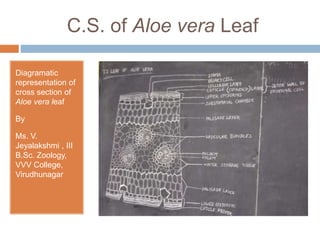Xerophytes
- 1. Dr. B. KARUNAI SELVI ASSISTANT PROFESSOR OF BOTANY V.V.VANNIAPERUMAL COLLEGE FOR WOMEN VIRUDHUNAGAR- 626 001 TAMIL NADU, INDIA karunaiselvi@vvvcollege.org Xerophytes
- 2. Xerophytes are plants which able to survive in an environment with little availability of water XEROPHYTES- ADAPTATIONS
- 3. Root Roots posses a number of root hairs and well developed root caps. Roots are covered with thick cork-like layer. It protects the inner tissues. eg. Pinus edulivs, Calotropis storage tissues. They have well developed stelar system. Intercellular spaces are very much reduced. Mechanical tissues are well developed and made of thick walled cells.
- 4. Stem In succulent xerophytes stem posses a water storage region. In Non-succulents Cuticle is very thick. Epidermis is well developed, with thick and cell walls. Hypodermis is several layered and sclerenchymatous. Stomata are sunkun type. Vascular tissues are very well developed, differentiated tissues are very well developed. Bark is very well developed.
- 5. Leaves - Succulent Epidermal cells of leaves serve as water-storage organs. Eg : Peperomia. They have prominent water storage regions in their mesophyll. Eg: Aloe. Cuticle is thick-heavily deposited with cutin and cellulose. Aloe vera
- 6. Leaves - Non - succulent Well developed heavy cuticle. Several layered epidermis. Eg: Nerium. Several layered sclerenchymatous hypodermis in Pinus. Mesophyll very well differentiated in to palisade and spongy parenchyma. C.S. Of Nerium Leaf Under compound Microscope
- 7. C.S. of Nerium Leaf Diagramatic representation of cross section of Nerium leaf By Ms.V Jeyalakshmi III B.Sc. Zoology, VVV College, Virudhunagar
- 8. Stomata of sunken type confined only to lower epidermis. Eg:Nerium. Vascular tissues are very well developed differentiated in to xylem with lignified elements and phloem. In Pinus, well developed complex transfusion tissues are present. C.S. of Pinus Needle
- 9. C.S. of Aloe vera Leaf Diagramatic representation of cross section of Aloe vera leaf By Ms. V. Jeyalakshmi , III B.Sc. Zoology, VVV College, Virudhunagar
- 10. Rolling of leaves Grooves are seen on the adaxial surface. Stomata are seen only in the grooves. Vascular bundles are present in the ridges. Mesophyll cells are sclerenchymataus. Photosynthetic tissues are present at the grooves. Rolled leaf
- 11. Physiological adaptation - Stomata In dark plants respire and produce acids. Acids in the guard cells increases osmotic concentration. This cause inward flow of water in the guard cells. guard cells turgid, the stomata open. In light acids dissociate to produce Co2. Co2 used up in the photosynthesis. Osmotic concentration of cell sap decreases. This cause closure of stomata. Stomatal opening Stomatal Closing
- 12. Physiological adaptation of xerophytes The chemical compounds of cell sap are connected in to wall forming compounds They are finally incorporated in to cells walls. Polysaccharides converted in to cellulose, formation of suberin. Catalases, peroxidases are more active: Amylase enzyme hydrolyses the starch very actively. Drought resistant capacity due to Structural features. Resistance of hardened protoplasm to heat and desiccation.
- 13. Regulation of transpiration Transpiration regulated by Cuticle Polished surface Compact cell Sunken stomata Stomatal hairs High osmotic pressure of cell sap: High osmotic pressure increases the turgidity. High osmotic pressure affects the observation of water.














